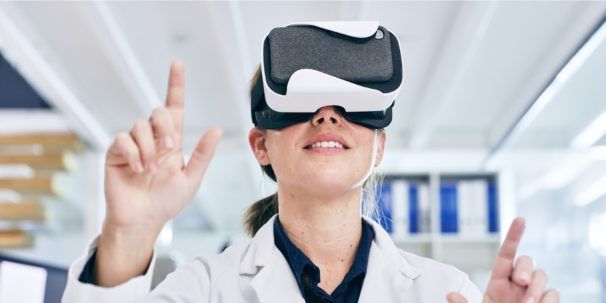The future of healthcare technology: How is medicine changing?
Healthcare innovation is one of the most important battles in the fight to prolong human life, so here we discuss which medical technologies are leading the way to a brighter future.

The future of healthcare holds many possibilities, and medical technology has a large role to play in ensuring that we are able to tackle all of the biggest health issues we face. Often, we consider healthcare jobs to be very human labour intensive; for example, doctors and nurses put in a lot of hours and physical work to look after patients.
However, it is new healthcare technologies that allow medical professionals to progress in their field, save more patients and fight new diseases. In this article, we’ll explore global healthcare in the current climate and how the industry has changed in the past decade, before discussing seven promising new healthcare technologies.
What is healthcare technology?
Before we discuss the current state of the global healthcare industry and how it’s changed over the past decade, we’ll offer a definition of healthcare technology. It’s fairly self-explanatory – any technology that is designed to support healthcare organisations.
The World Health Organisation (WHO) offers a more detailed definition of health technology, as the “application of organized knowledge and skills in the form of devices, medicines, vaccines, procedures, and systems developed to solve a health problem and improve quality of lives”.
>> Discover our collection of online healthcare degrees
What does global healthcare look like in 2021?
The healthcare industry has undoubtedly changed in the past couple of years since we’ve been fighting a global pandemic. COVID-19 overwhelmed healthcare systems all over the world, has killed as many as 3 million people worldwide, and forced many other dangerous diseases to be placed on the sidelines.
While social distancing and mask-wearing reduced the spread of infectious diseases like the flu, lockdowns and restrictions also meant that fewer people were getting diseases diagnosed and receiving important treatment.
However, one good thing that has come out of the pandemic is that more of the world now has access to healthcare through things like digital appointments and online prescriptions.
Thinking about the global healthcare outlook outside of COVID-19, Deloitte Insights wrote a report detailing six of the biggest factors driving change in the healthcare sector.
They suggest that consumers are seeking more on-demand, digital healthcare services, and healthcare organisations are transitioning to health IT systems powered by cloud, data and analytics tools.
In addition to this, we’re shifting to view healthcare as something encompassing our total wellbeing rather than just our physical health, and we’re seeing more collaboration between different governments, industries, academia and tech giants than ever before, in the name of healthcare innovation and progression.
How has the healthcare industry changed in the last 10 years?
Since we’re thinking about what healthcare could look like in the future, it’s worth acknowledging the amount of progress that has been made in the healthcare industry in the past decade. Below we discuss some of the biggest innovations that have changed healthcare for the better.
Remote monitoring
Remote monitoring allows patients and their progress to be monitored at all times without using clunky technology or a doctor needing to be present. Not only does this mean that doctors and nurses are able to help many patients at once, but patients are able to leave the hospital earlier and be monitored safely from afar. This creates a more comfortable and cheaper experience for everyone involved.
Electronic medical records
Since the introduction of electronic medical records, it’s been so much easier for doctors to view and seamlessly share medical history. This means that records are less likely to be lost and patient care is improved because the doctor has complete access to the patient’s health background, prescriptions and previous care. Electronic records also allow patients themselves to keep track of their medical data.
Telemedicine
Telemedicine consists of remote clinical services where the healthcare provider or doctor communicates virtually with the patient. Examples of this include appointments with a GP over video call, therapy over the phone, and text messages that reveal medical test results.
The positive consequences of this are undeniable – access to healthcare has been improved for those who are in remote areas or who face difficulties attending physical appointments.




Advantages and disadvantages of medical technologies
Before we dive into the seven new healthcare technologies of the future, it’s worth considering the advantages and disadvantages of medical technology. While the benefits outweigh the costs, there are still some drawbacks to be aware of.
Advantages of medical technology
- More efficient healthcare systems
- More accessible healthcare
- Earlier predictions of diseases
- Faster surgery and recovery times
- Better analysis of healthcare data
- Faster development of drugs and vaccines
- Increased legibility of medical documents
Disadvantages of medical technology
- Forces reliance on internet connection – it’s harder for rural healthcare providers to communicate with each other and with patients
- Bigger risk of serious security breaches due to data sharing
- Higher chance of miscommunication in virtual appointments
- Lack of empathy due to it being more impersonal or relying on AI
- More expensive for healthcare providers and patients
- High chance of frustration if technology fails
7 promising new healthcare technologies
There are so many exciting new medical technologies being used in the healthcare industry, but these are some of the most prominent. Some of them have been around for a little while now, but they are becoming more technologically advanced as time goes on.
AI & robots
Artificial intelligence (AI) has so many exciting applications in healthcare. One of the most important applications is in diagnosis, as there have been several situations in which AI has been able to identify diseases like skin cancer and diabetic blindness better than experts in the field. You can find out more about this in our What are the Possibilities of AI in Healthcare? open step by Taipei Medical University.
Other than diagnosis, AI can be used to perform routine tasks, manage data, design treatments, manage medication, monitor health and more. AI can even be used on robots, and then these robots can act as medical assistants, take lab samples, assist in surgeries, and disinfect hospital rooms.
Clearly, there’s a lot of room for further development in the field of AI in healthcare, and AI holds plenty of challenges, but we could see some really life-changing results. To learn more, you could try our MedTech: AI and Medical Robots course by the University of Leeds or our AI for Healthcare: Equipping the Workforce for Digital Transformation course by the University of Manchester and the NHS.
Nanotechnology for diagnosis
Another innovative technology in the medical field is nanotechnology for diagnosis. You may not have heard of nanotechnology before, but it’s concerned with objects that have at least one dimension under 100 nanometres (nm) in size. One nanometre is one-billionth of a metre. You can learn more about nanotechnology in our open step.
So what does this have to do with diagnosis? Essentially, nanotechnology can be used to recognise unique cells and identify genetic content that might signify disease. This then allows drugs to reach specific damaged cells whilst avoiding healthy ones.
If this is of interest, you can join our Nanotechnology for Health: Innovative Designs for Medical Diagnosis course by the University of Twente and explore the potential of nanotechnology products in medical applications.






eHealth apps
eHealth refers to the use of technologies to improve healthcare, including health and wellbeing. Therefore, eHealth apps are mobile applications that tend to target a specific area of healthcare. Since almost everyone has a smartphone these days, eHealth apps make looking after your health and wellbeing feel more accessible and less daunting.
Good examples include Coala, a heart monitoring app that comes with a mini ECG device, and Elsa, an app that helps people with chronic illnesses monitor how they feel and why. To learn more about eHealth, you can try our eHealth: Combining Psychology, Technology, and Health course by the University of Twente.
Internet of Things
In our open step, The Internet of Things and the future, experts define IoT as any “set of sensors and actuators embedded in physical objects that are linked through wired or wireless networks”. In recent years, there have been plenty of innovations in the healthcare industry that fall under the Internet of Things, and they allow patients to take control of their own health.
This is important because often, people experiencing health difficulties feel a total lack of control, and this can have negative consequences on mental health. Some examples of IoT applications in healthcare include wearable technologies like sleep monitors and glucose trackers.
You can learn how IoT can give agency to ageing people and help them deal with medical issues in our Internet of Things for Active Aging course by Taipei Medical University.
Future of genomics
Genetics is a fast-moving and innovative field in medicine, with so many possibilities. While it may be one of the more controversial medical fields, it has exciting applications, including early detection of diseases, synthetic DNA production, and faster, cheaper DNA testing.
To discover more about innovations in genetics and genomics, you can try our MedTech: Exploring the Human Genome course by the University of Leeds or The Genomics Era: the Future of Genetics in Medicine course by the St George’s University of London.
Regenerative medicine
Regenerative medicine is what you might imagine – medical treatment that seeks to replace damaged tissue or organs. Clearly, progress in this area is invaluable, and there’s no knowing how far regenerative medicine will be able to go in the future.
Some examples of current innovations in this field include tissue engineering, cellular therapies and artificial organs. To learn more, our MedTech: Orthopaedic Implants and Regenerative Medicine course by the University of Leeds will teach you how stem cells are used for tissue engineering, among other things.
Orthopaedic implants
The final healthcare technology we’ll be discussing is orthopaedic implants, which are manufactured devices that replace damaged bones, joints or cartilage. The market for orthopaedic implants is growing at a fast rate, with more products being released than ever before.
Now, patient-specific, customisable orthopaedic implants made with revolutionary 3D technology are becoming more common, so it’s an exciting area to keep tabs on. Again, our MedTech: Orthopaedic Implants and Regenerative Medicine course will teach you more about this topic.
What will the future of healthcare look like?
Now that we’ve evaluated the global health situation and explored some of the innovations that exist, it’s safe to say that the future of healthcare holds plenty more scientific breakthroughs and opportunities for digital innovation.
A recent McKinsey Global Institute report suggested that by 2040, global disease could fall by 40%, and 70% of this would be made possible by preventative measures. Some of the technologies we’ve discussed today could help form part of this preventative care, so it’s worth learning more in order to secure a brighter future for us all.
Our medical technology courses are the perfect place to discover all of the health innovations driving change today. Whether you’re a medical professional or just interested in the future of society, you’ll learn something that inspires you.









